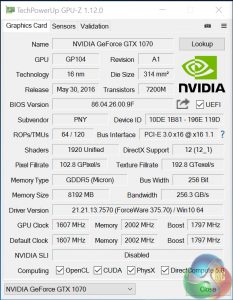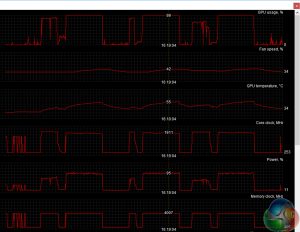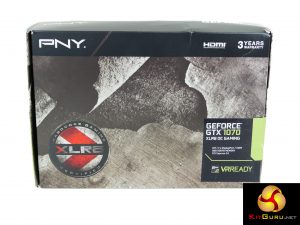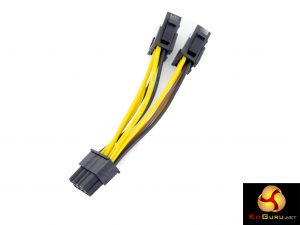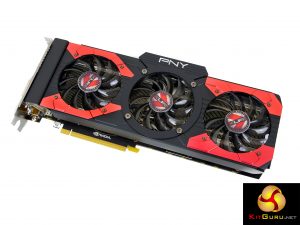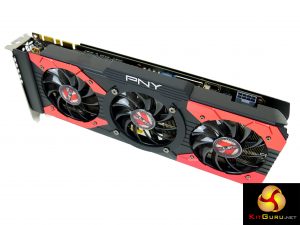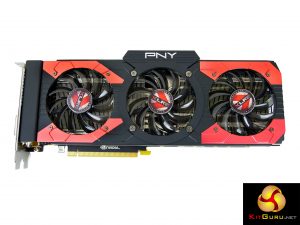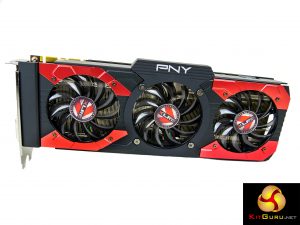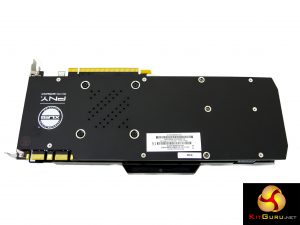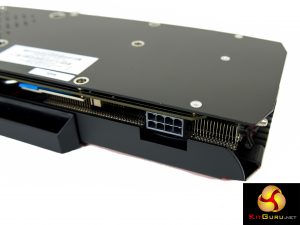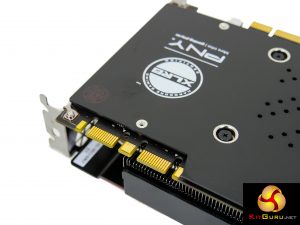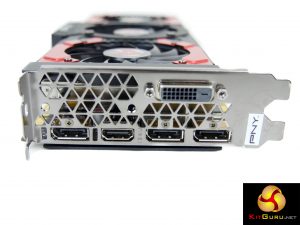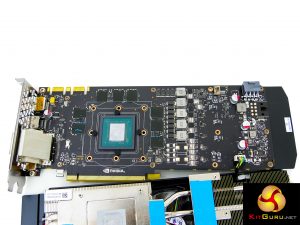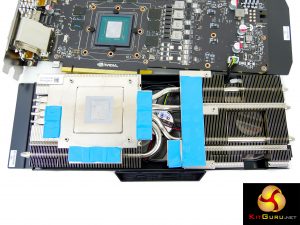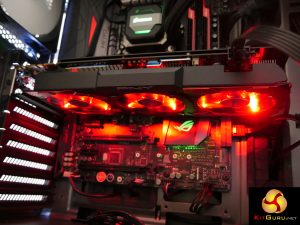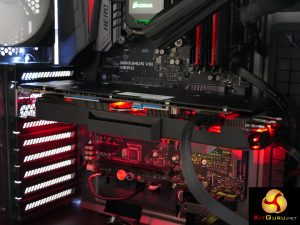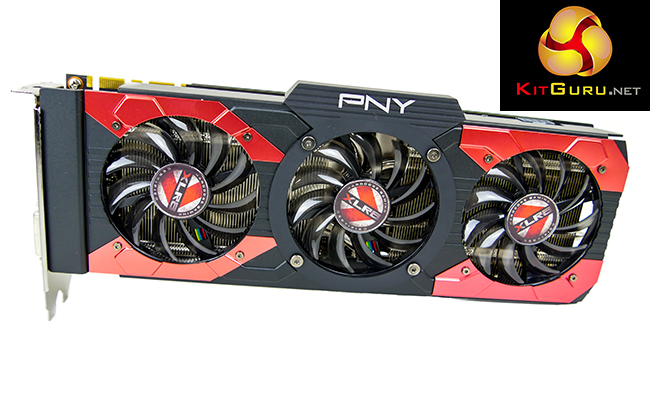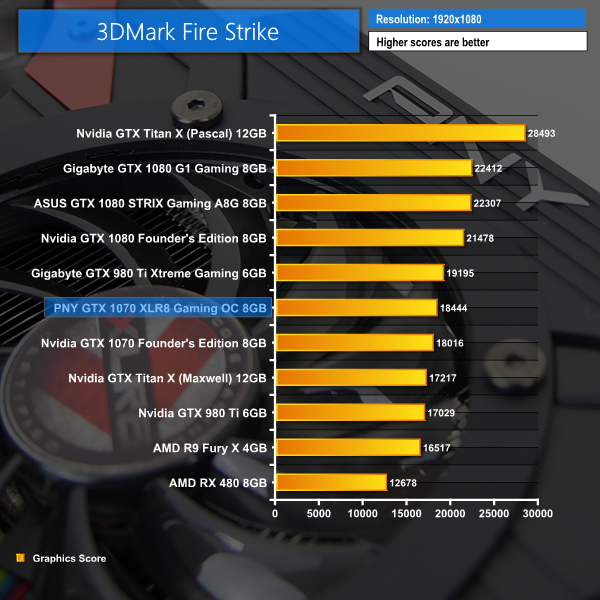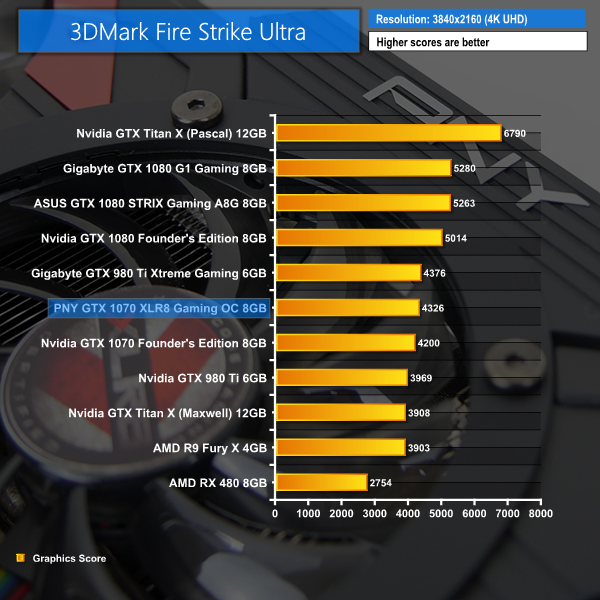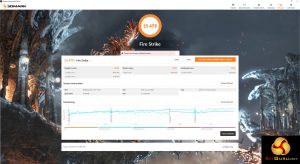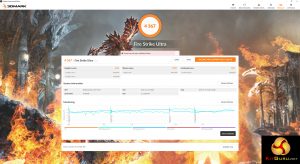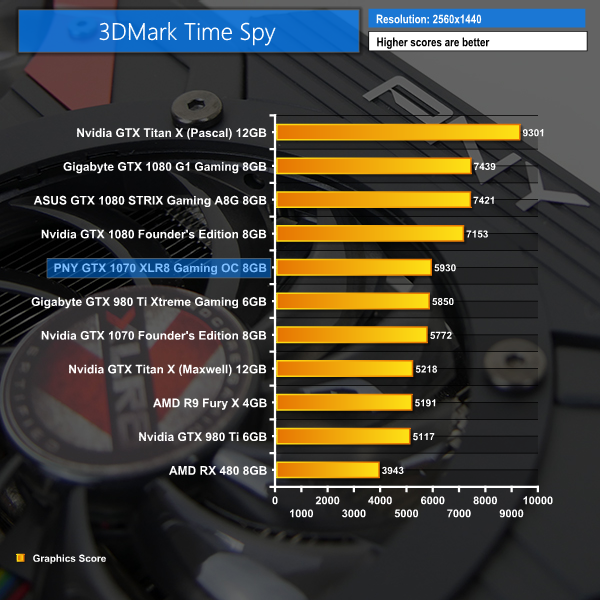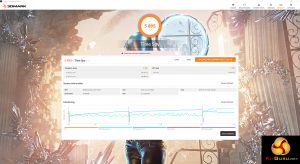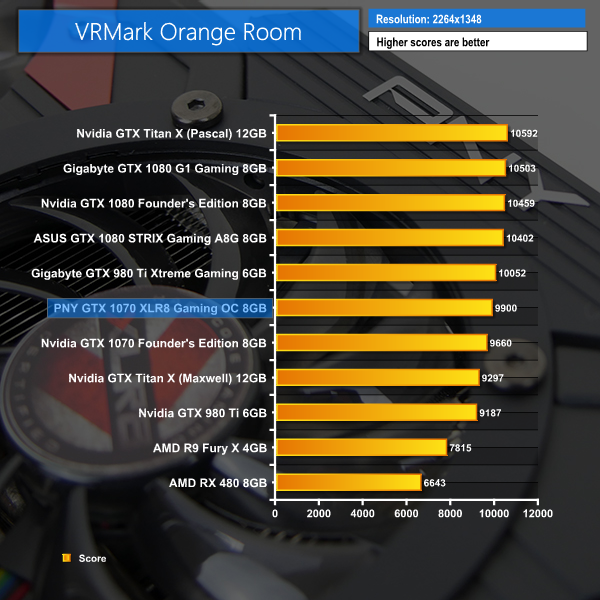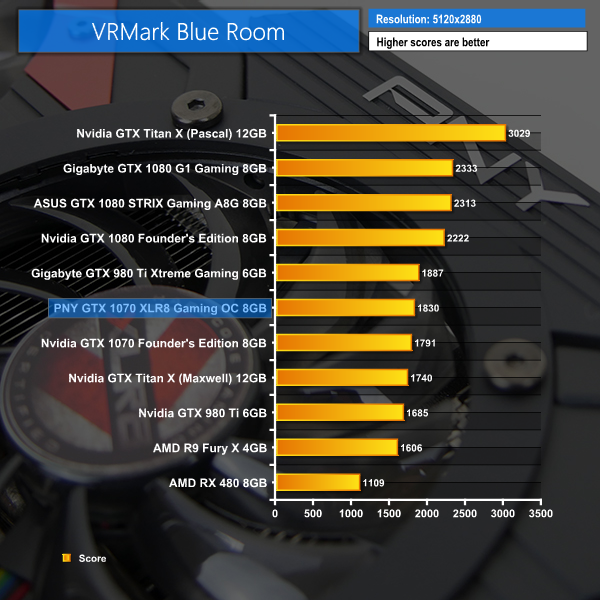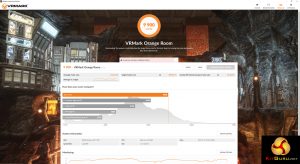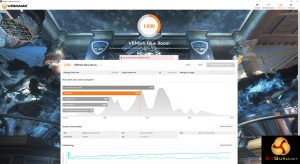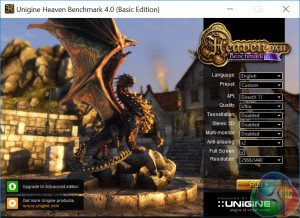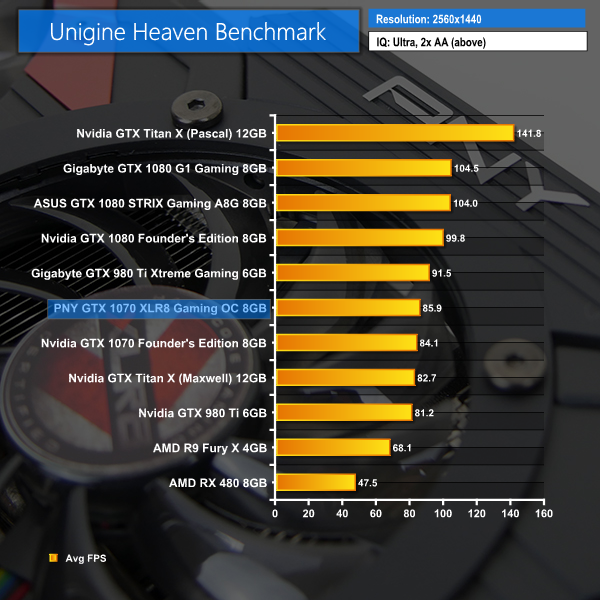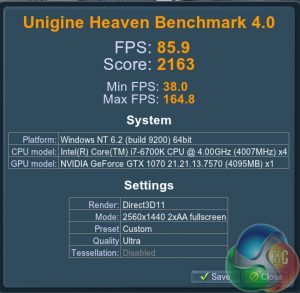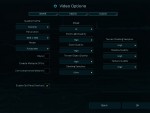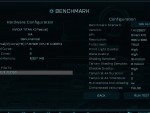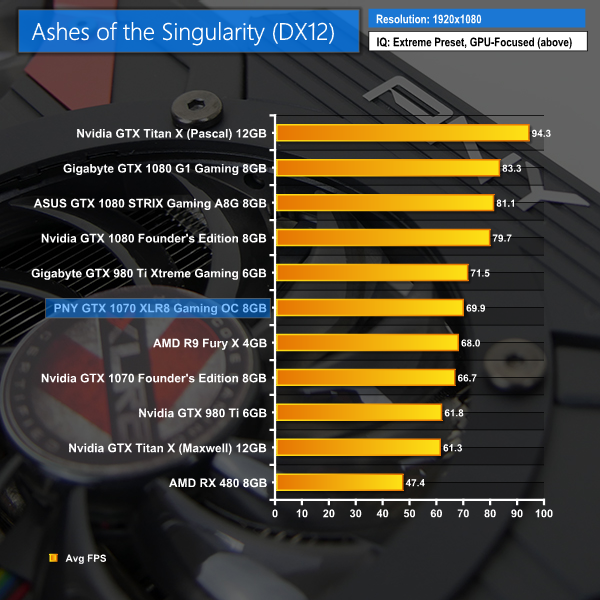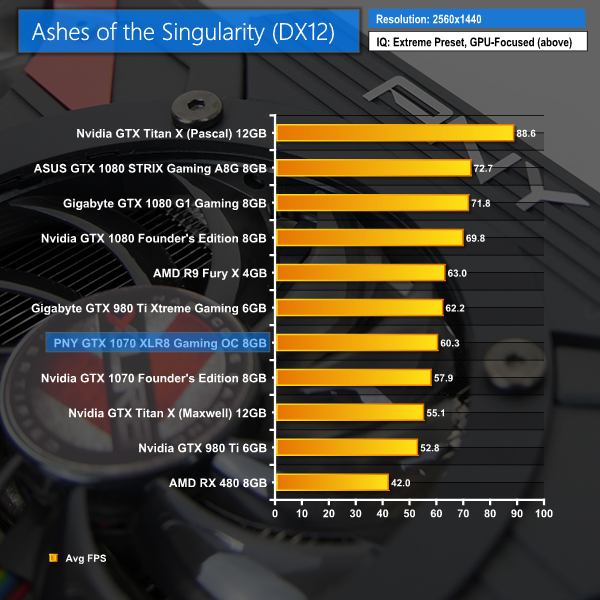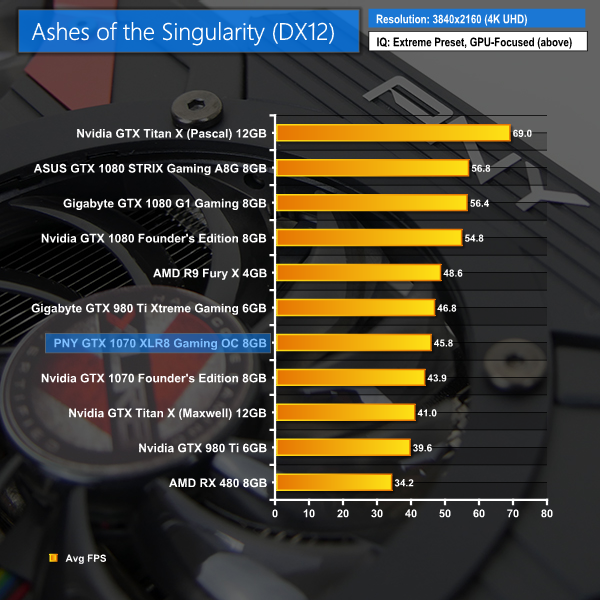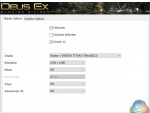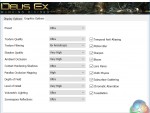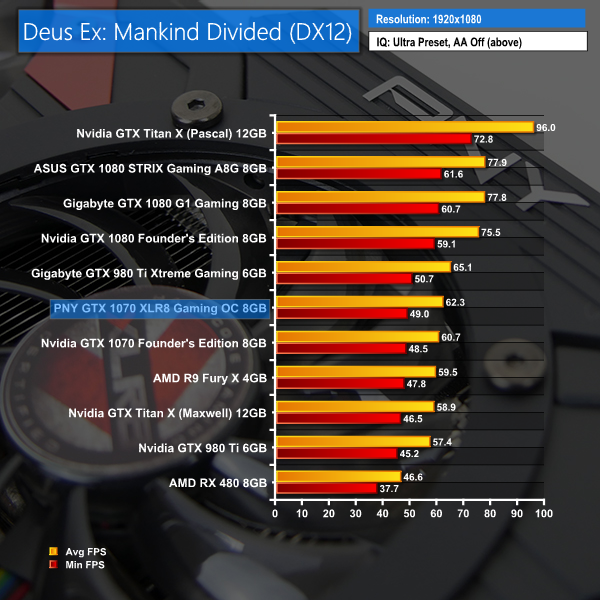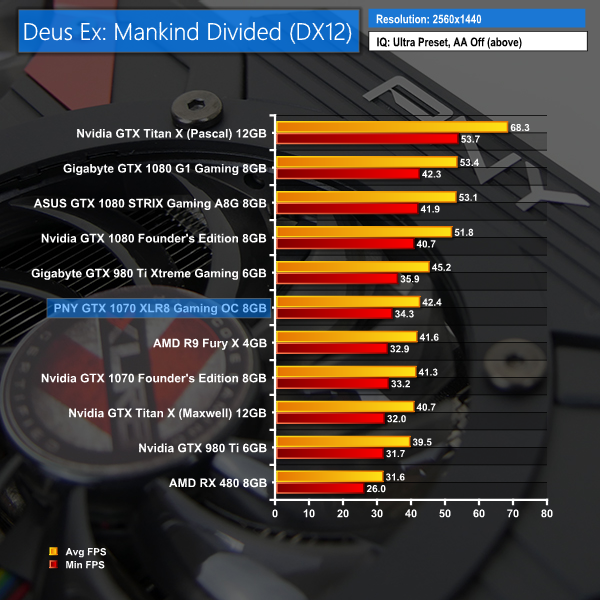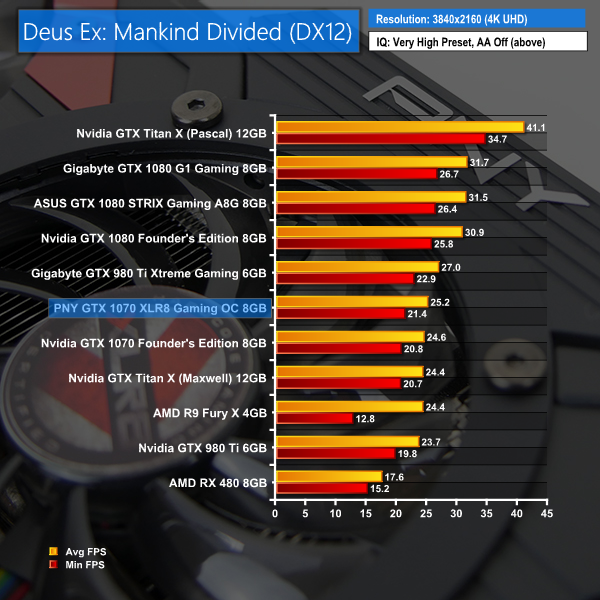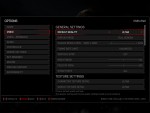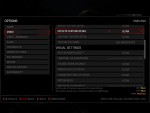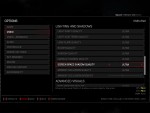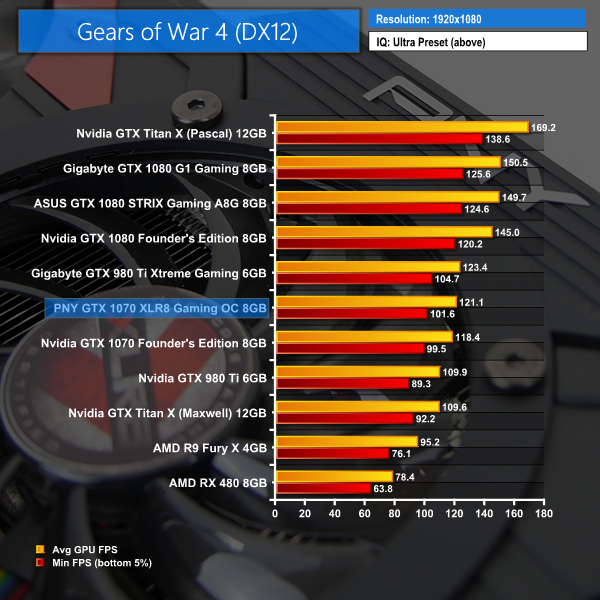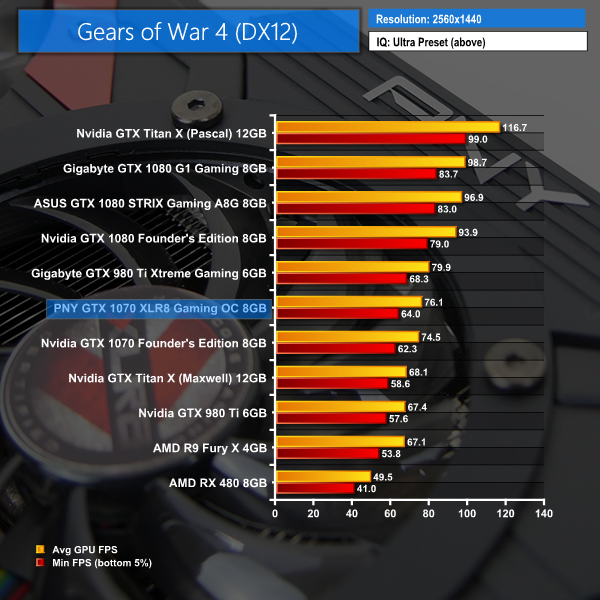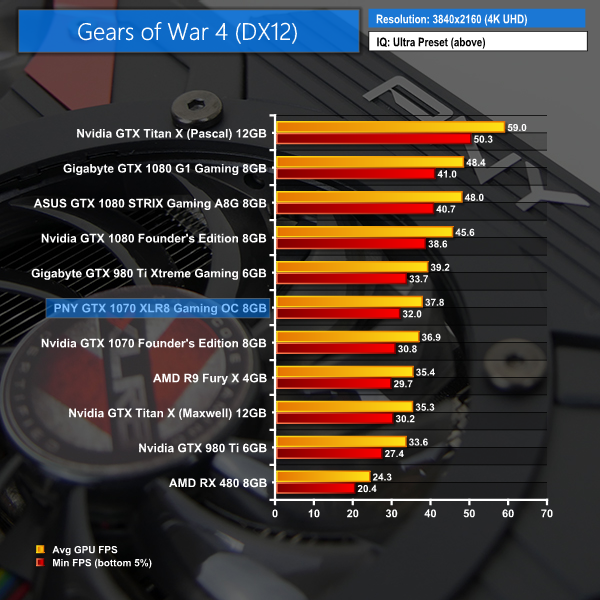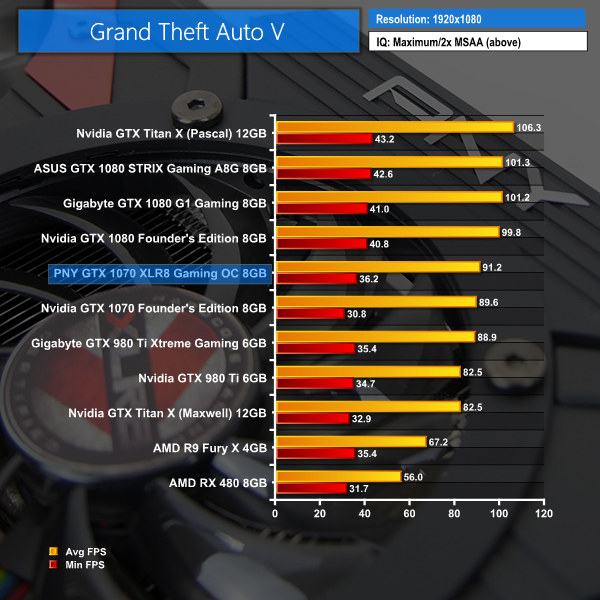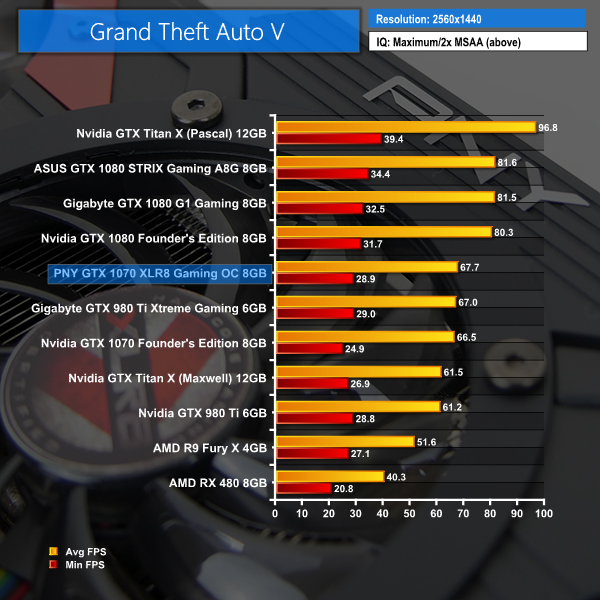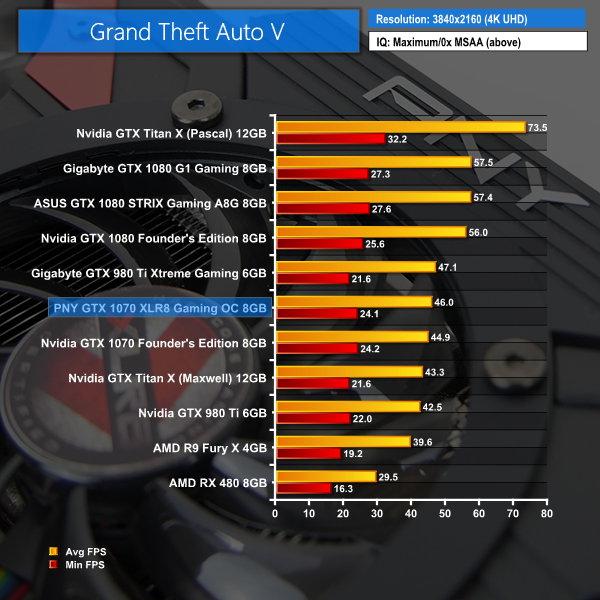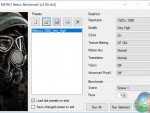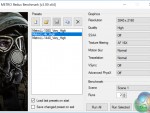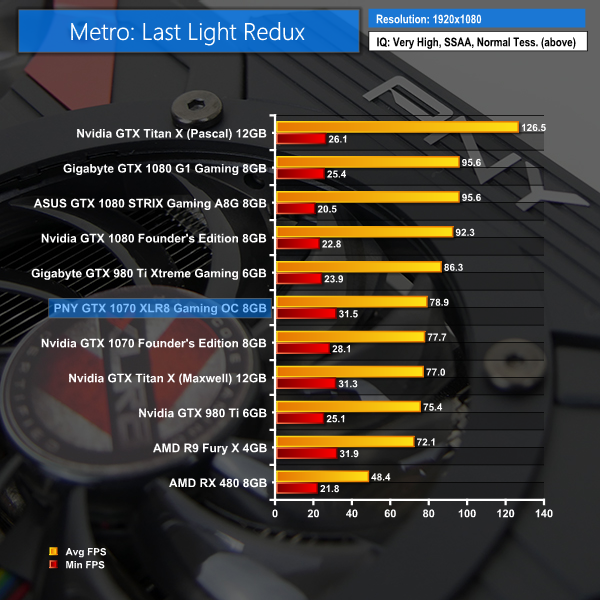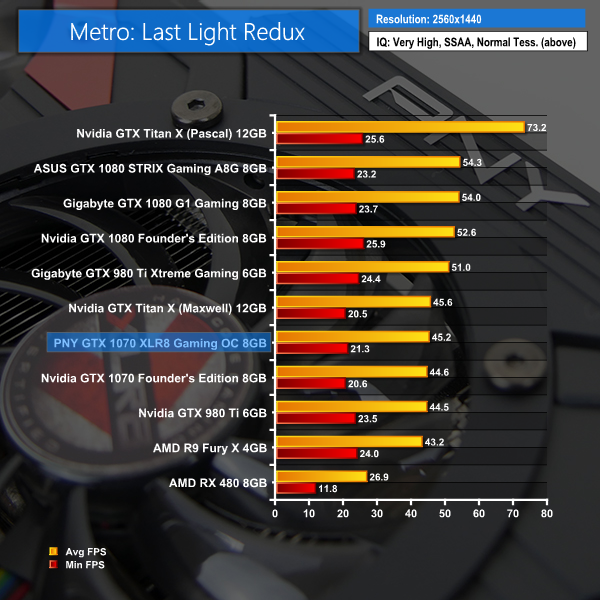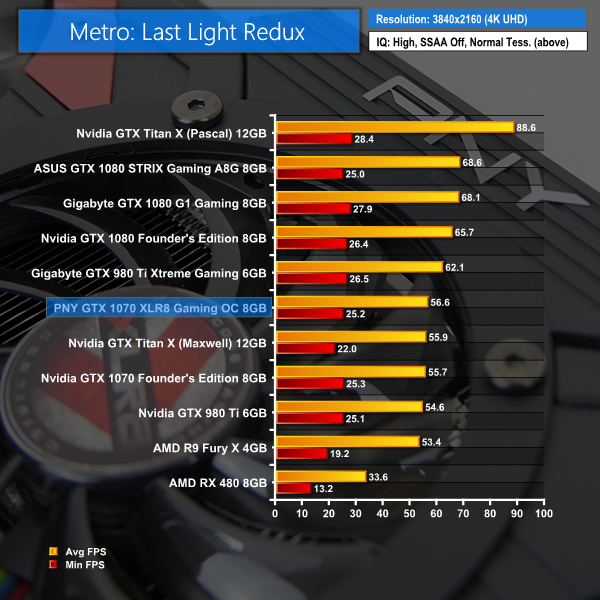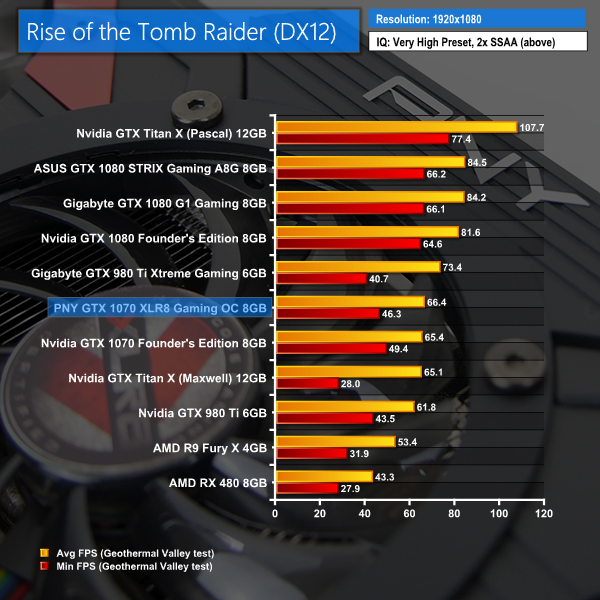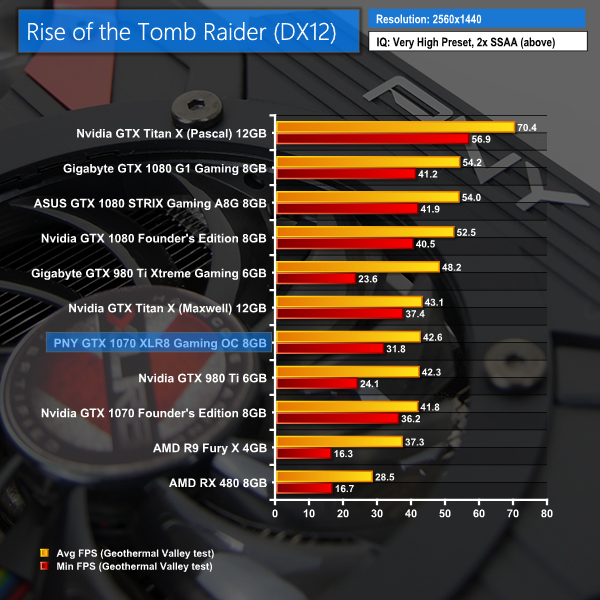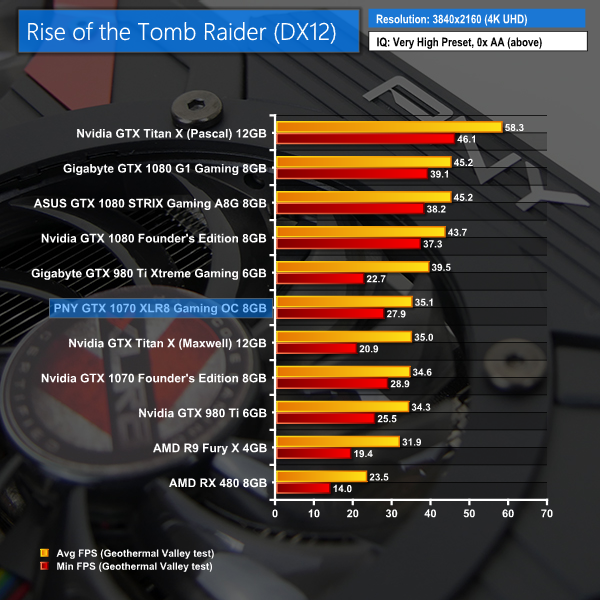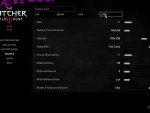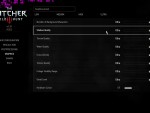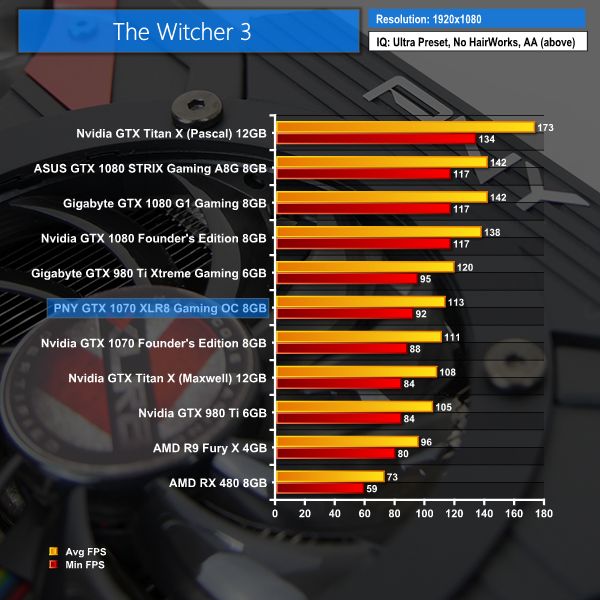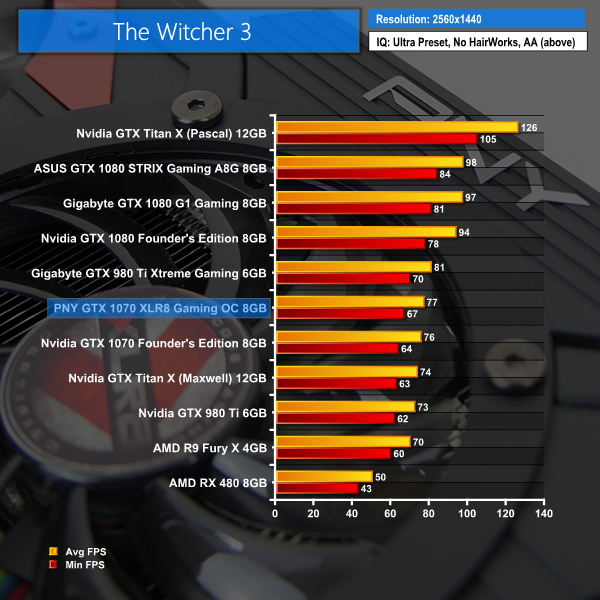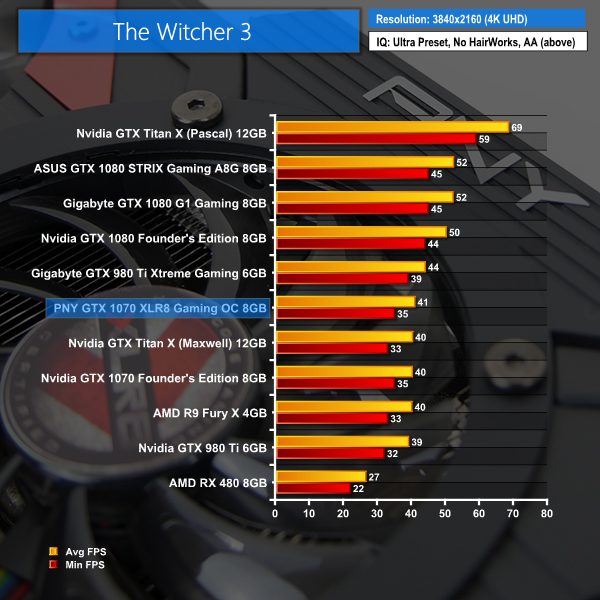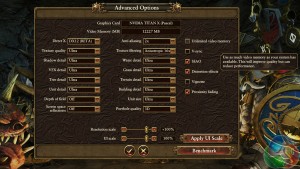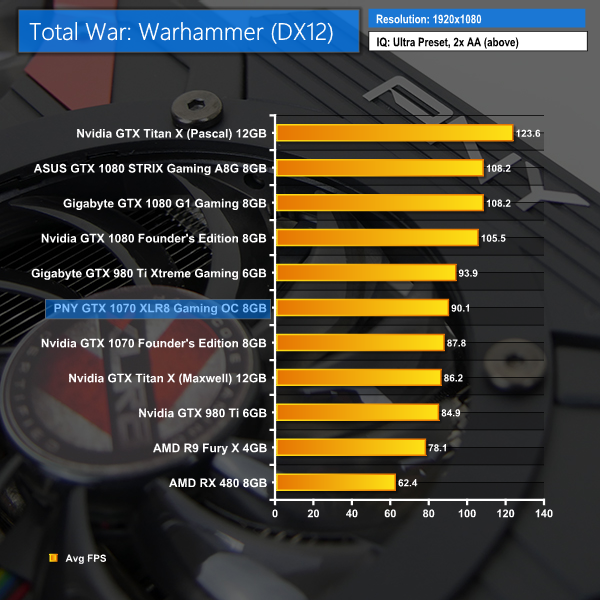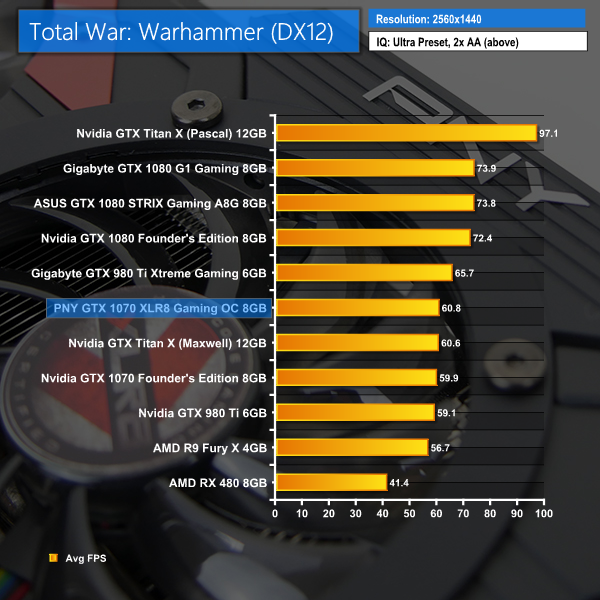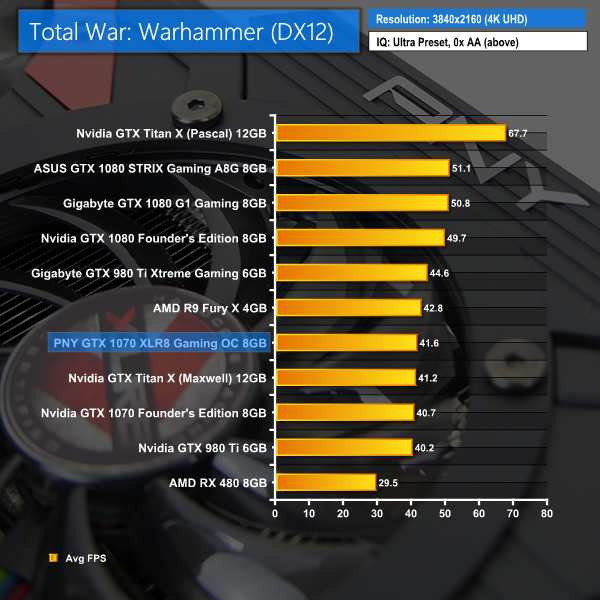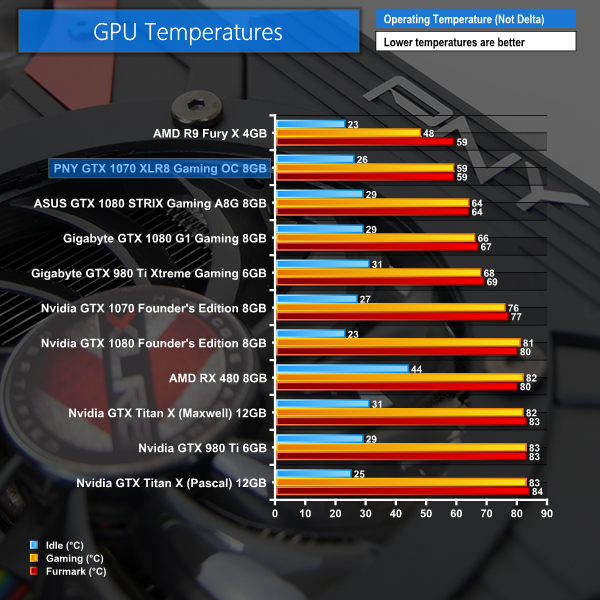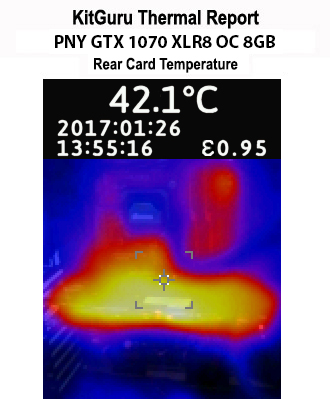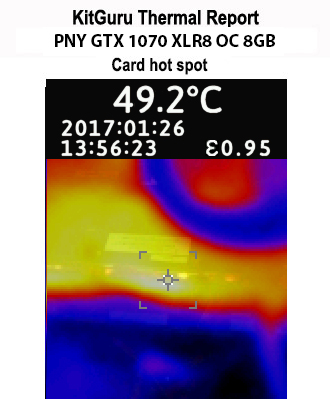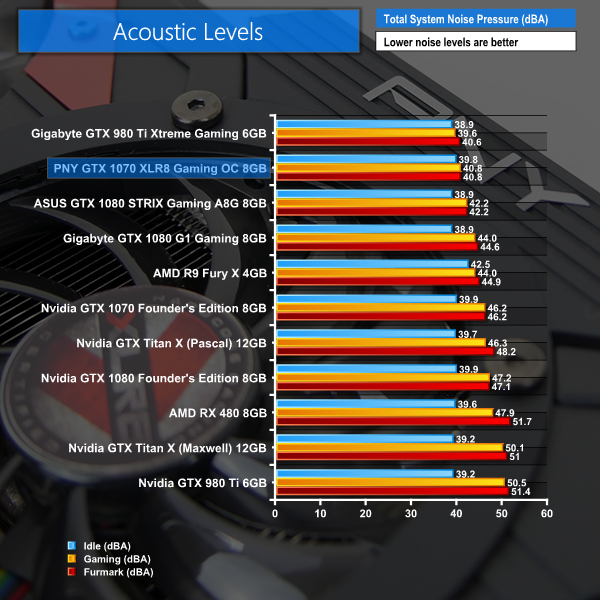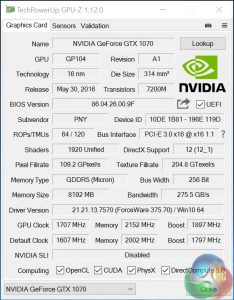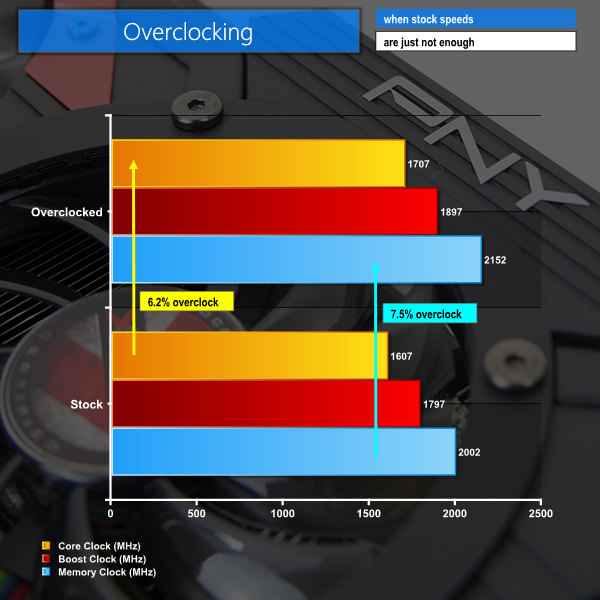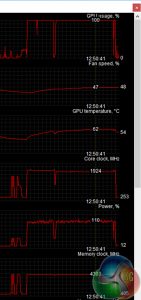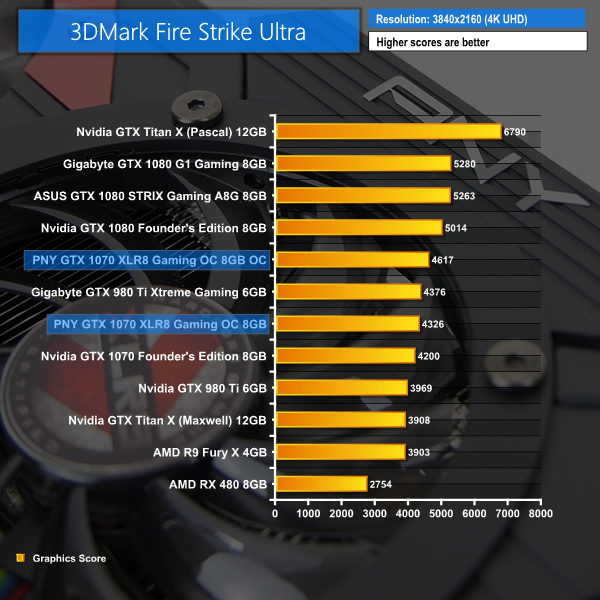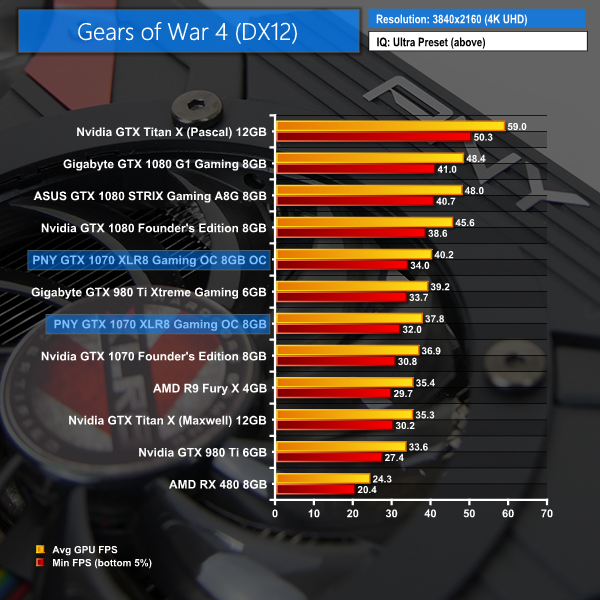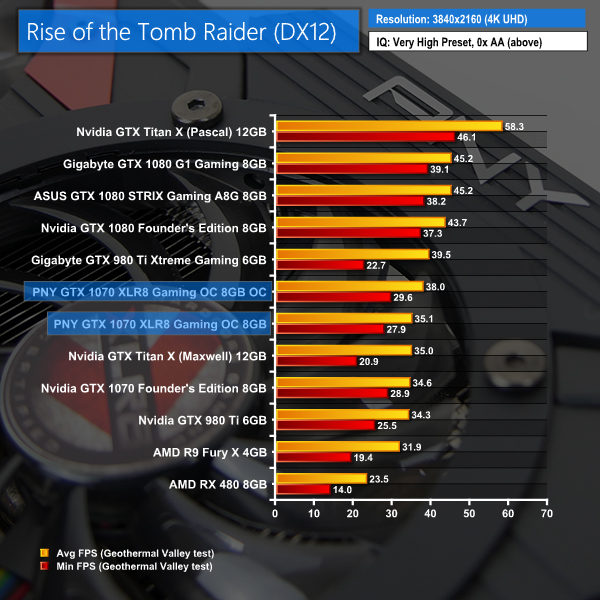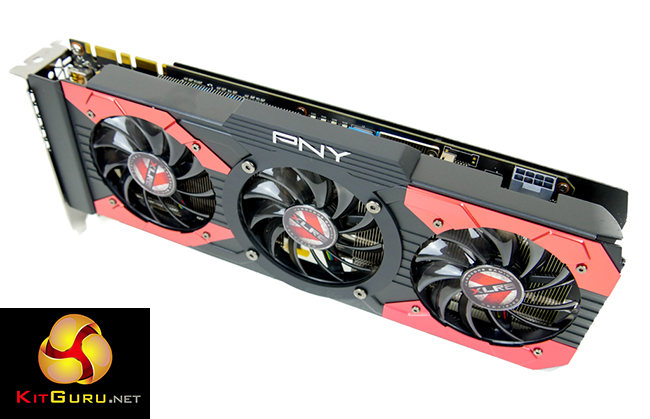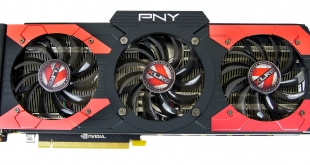
Nvidia’s GTX 1070 graphics card remains the go-to option for 1440p gaming enthusiast due to a (current) lack of modern competition from AMD and the sheer expense of the GTX 1080 and Titan X Pascal chips. More than half-a-year after its launch and the GTX 1070 is still managing to hold its price in the UK, aided by the political events of 2016. We examine PNY’s ~£450 GTX 1070 XLR8 OC to see how the company’s triple-fan cooler and aggressive core overclock tackle modern games.
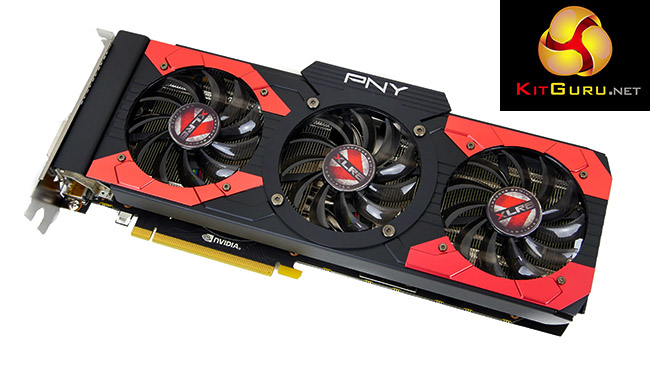
Going with a gamer-orientated style from yesteryear, PNY colours the GTX 1070 XLR8 OC’s triple fan cooler in a red and black style. Red LEDs are also fitted to the board and activate continuously when one’s system is powered on. If you like red in your system, PNY has made a good start on this card.
Good news for tinkerers who may be toying with the prospect of watercooling in the future, PNY uses the same reference GTX 1070 PCB for its XLR8 OC card. You get the same 4+1 phase power delivery system and single 8-pin PCIe power connector feeding the GP104 GPU and 8GB of GDDR5 memory.
Despite the included backplate, there are no flashy RGBs or 0dB fan operating modes for the GTX 1070 XLR8 OC so PNY is clearly relying upon build quality and straight-up performance to win over buyers.
PNY overclocks the core to 1607MHz (1797MHz Boost) which is an aggressive increase from the 1506MHz/1683MHz reference GTX 1070 FE frequencies. Memory is left unchanged at 8Gbps effective.
As shown in the MSI Afterburner screenshot above, PNY’s GTX 1070 XLR8 OC will happily hover around and just above the 1900MHz GPU Core clock mark under gaming conditions. The higher the resolution, the lower the boost speed, but even at 4K the card would sit around 1911MHz.
PNY sends the GTX 1070 XLR8 OC graphics card in basic packaging with a bundle that includes documentation, the drivers CD, and a very ugly dual-6-pin to 8-pin PCIe power connector.
Bin the CD and download the latest drivers from Nvidia and kiss goodbye to your good-looking build if you are forced to use the yellow-and-black PCIe power adapter.
A quite light red and a dark brown are the two tones used for PNY’s styling on the GTX 1070 XLR8 OC. The red accents have a slightly metallic finish to them which helps to bounce small pockets of light. A dark, translucent plastic is also used for the 80mm fans’ blades and this helps the bright red LEDs to shine through.
By virtue of its XLR8 cooler with triple 80mm fans, the card itself measures in at just under 30cm in length. Width is extended by around 1cm to provide the mounting location for the PNY logo. This seems a little pointless as there could be scenarios where any extra card width can cause interference issues (small SFF cases, for example).
PNY’s XLR8 did not operate with a 0dB fan mode in our testing, which is disappointing. Aside from completely eliminating noise output from the card’s cooler, stationary fans help to enhance their usable lifespan by minimising wear and tear and also reduce the amount of dust blown into the aluminium fin array.
A full-cover black backplate is fitted on the card to improve heat dispersion on the rear of the PCB and to also aid its aesthetics. The styling of the backplate is simple and effective – there are not explicit cut-outs for logos or graphics and a complete lack of LEDs may appeal to some people.
However, PNY prints its logo and text facing the opposite direction of a typical installation inside one’s chassis. With the graphics card installed, the logo and text will appear 180° in the wrong orientation compared to where a user sits and looks through their chassis side panel. This is a minor point but it is also a clear oversight on PNY’s behalf.
Positioning of the ugly barcode sticker is also questionable. This will be mounted front-and-centre when the card is installed in one’s system. Hiding it away in one of the corner of the backplate would have been a smarter design decision.
The 150W TDP GP104 GPU sips power from a single 8-pin PCIe connector mounted on the side of the card. Given the standard-width PCB, there should be no interference problems pressing down the clips on a PCIe power connector when attaching or removing it.
Two SLI fingers are found in their usual location. Given PNY’s use of a reference PCB, this XLR8 OC model can be used in SLI with another reference-style GTX 1070 (such as the FE) as the rigid HB SLI bridge will be positioned correctly. A wider-than-standard card would not allow for SLI between itself and a reference PCB alternative.
PNY sticks to the GTX 1070’s default configuration when it comes to display outputs. Three DisplayPort 1.4 connectors, an HDMI 2.0b, and Dual-link DVI-D (no analogue pins) form the display output options. 4K60 connections can be made using the DP 1.4 and HDMI 2.0b ports. 8K60 or 4K120 can also be output using the DisplayPort connections. Dual-link DVI-D is fine for resolutions such as 1920×1080 or 2560×1440 at 60Hz.
A significant amount of venting is used on the rear slot in an attempt to lessen the resistance for air trying to exit the graphics card and chassis.
Removal of the triple-fan XLR8 cooler reveals the reference-design GTX 1070 PCB used by PNY. There are slight tweaks to the chosen power delivery electronics but the adjustments are minor and should not impact aftermarket cooler compatibility.
Four heatpipes (presumably manufactured from nickel-plated copper) are given flattened sections that make contact with a large baseplate which acts as the first point of contact to the GPU die. The section above the heatsink baseplate will receive a significant amount of thermal energy from the GPU, while the four heatpipes transfer additional heat to outer edges of the aluminium fin arrays for it to be dissipated.
I like this design. It avoids the issues of poor contact by certain heatpipes in an alternative Heatpipe Direct Touch (HDT) solution. And a total of four heatpipes looks to be adequate given PNY’s smart routing of them with respect to the primary contact plate location and the size of each fin array. One slight issue, however, is that the centre 80mm fan is not pushing most of its air onto a section of the fin arrays. This may work well for reducing PCB and inductor temperatures but it does little to aid the overall GPU and memory/MOSFET cooling solution.
Eight memory chips form the 8GB GDDR5 buffer used by the GTX 1070. PNY uses thermals pad to enable cooling of the memory chips which is good to see and may aid component longevity. The hot-running MOSFETs are also cooled by means of a thermal pad linking them to an actively cooled section of the aluminium heatsink.
Dark red LEDs shine brightly through the fan blades of the XLR8 cooler. If you like red, this card is likely to have you very pleased as the colour is bright and the tone of red is bold. Plenty of light spills beneath the card and illuminates hardware beneath it very well. It would have been nice for more of the light to spill out of the sides and become visible when installed inside one’s system.
It is, however, disappointing to see that only red colouring is available in today’s world of RGB-everything. Equally disappointing to some users will be the inability to deactivate the LED lighting.
Our newest GPU test procedure has been built with the intention of benchmarking high-end graphics cards. We test at 1920×1080 (1080p), 2560×1440 (1440p), and 3840×2160 (4K UHD) resolutions.
We try to test using the DX12 API if titles offer support. This gives us an interpretation into the graphics card performance hierarchy in the present time and the near future, when DX12 becomes more prevalent. After all, graphics cards of this expense may stay in a gamer's system for a number of product generations/years before being upgraded.
General Test System Notes
- AMD Graphics cards were benchmarked with the AMD Crimson Display Driver 16.11.4.
- Nvidia Graphics cards were benchmarked with the Nvidia Forceware 375.70 driver.
Test System
| CPU |
Intel Core i7 6700K ‘Skylake' (Retail)
Overclocked to 4.4GHz Core, 4.4GHz Cache |
| Motherboard |
ASUS Maximus VIII Hero
|
| Memory |
G.Skill Trident Z
16GB (2x8GB) @ 3000MHz 16-18-18-38-2T |
| Graphics Card |
Varies
|
| System Drive |
Micron M600 256GB SATA 6Gbps SSD
|
| Games Drive | SK hynix SE3010 960GB SATA 6Gbps SSD |
| Chassis | NZXT Phantom 630 (medium fan speed) |
| CPU Cooler |
Corsair H110i GT
|
| Power Supply |
Seasonic SS-760XP 760W Platinum
|
| Operating System |
Windows 10 Professional with Anniversary Update (64-bit)
|
Our test system consists of an overclocked Core i7-6700K processor and 16GB of 3000MHz G.Skill DDR4. High-end hardware is used to eliminate CPU and memory from the bottleneck equation and put the performance onus solely on the GPU being tested.
Comparison Graphics Cards List
AMD RX 480 8GB Reference (1266MHz core / 2000MHz memory)
AMD R9 Fury X (1,050MHz core / 500MHz memory)
Nvidia GTX Titan X (Pascal) (1418MHz core / 1531MHz Boost / 1251MHz memory)
Gigabyte GTX 1080 G1 Gaming (1696MHz core/ 1835MHz Boost / 1251MHz memory)
ASUS ROG STRIX GTX 1080 Gaming A8G (1671MHz core/ 1810MHz Boost / 1251MHz memory)
Nvidia GTX 1080 Founders Edition (1607MHz core/ 1734MHz boost / 1251MHz memory)
Nvidia GTX 1070 Founders Edition (1506MHz core/ 1683MHz boost / 2002MHz memory)
Nvidia GTX Titan X (Maxwell) (1,000MHz core / 1,753MHz memory)
Gigabyte GTX980 Ti XTREME Gaming (1216MHz core / 1800MHz memory)
Nvidia GTX980 Ti Reference (1000MHz core / 1,753MHz memory)
Software and Games List
- 3DMark Fire Strike & Fire Strike Ultra (DX11 Synthetic)
- 3DMark Time Spy (DX12 Synthetic)
- VRMark Orange Room & Blue Room (Synthetic)
- Unigine Heaven (DX11 Synthetic)
- Ashes of the Singularity (DX12)
- Deus Ex: Mankind Divided (DX12)
- Gears of War 4 (DX12)
- Grand Theft Auto V (DX11)
- Metro Last Light Redux (DX11)
- Rise of the Tomb Raider (DX12)
- The Witcher 3: Wild Hunt (DX11)
- Total War: Warhammer (DX12)
3DMark Fire Strike is a showcase DirectX 11 benchmark designed for today's high-performance gaming PCs. It is our [FutureMark's] most ambitious and technical benchmark ever, featuring real-time graphics rendered with detail and complexity far beyond what is found in other benchmarks and games today.
Strong performance is shown by PNY's GTX 1070 XLR8 OC in the 3DMark tests. The overclock to its core allows PNY's card to outperform a Founder's Edition GTX 1070 by a small margin. Gigabyte's heavily overclocked GTX 980 Ti from the Maxwell generation is generally a slight bit faster than the GTX 1070 XLR8 OC.
Futuremark's new VRMark benchmark is the latest addition to our test suite. The recently-released benchmark aims to score GPUs based on their VR performance potential by using rendering resolutions associated with VR devices of today and the future.
The Orange Room test compresses the scores for high-end graphics cards and shows that many of today's options are capable of delivering a solid experience for HTC Vive and Oculus Rift-type resolutions (2264×1348 test resolution). Blue Room and its 5120×2880 rendering resolution, on the other hand, is an absolute killer for graphics cards but it does show tangible gains when stepping up through the performance hierarchies.
It's more of the same with VRMark – the PNY card sits above a GTX 1070 FE and below Gigabyte's overclocked GTX 980 Ti in terms of performance. The GTX 1080 cards cannot be touched, even with a solid overclock applied to the core of the GTX 1070 XLR8 OC model.
Unigine provides an interesting way to test hardware. It can be easily adapted to various projects due to its elaborated software design and flexible toolset. A lot of their customers claim that they have never seen such extremely-effective code, which is so easy to understand.
Heaven Benchmark is a DirectX 11 GPU benchmark based on advanced Unigine engine from Unigine Corp. It reveals the enchanting magic of floating islands with a tiny village hidden in the cloudy skies. Interactive mode provides emerging experience of exploring the intricate world of steampunk. Efficient and well-architected framework makes Unigine highly scalable:
- Multiple API (DirectX 9 / DirectX 10 / DirectX 11 / OpenGL) render
- Cross-platform: MS Windows (XP, Vista, Windows 7) / Linux
- Full support of 32bit and 64bit systems
- Multicore CPU support
- Little / big endian support (ready for game consoles)
- Powerful C++ API
- Comprehensive performance profiling system
- Flexible XML-based data structures
We set Quality to ‘Ultra’, Tessellation to ‘disabled’, Anti-Aliasing to 2x and the resolution to 2560×1440 (1440p).
Ungine shows the same trend as the 3DMark benchmarks. But this time the performance gap to Gigabyte's GTX 980 Ti Xtreme Gaming is widened and performance of the PNY GTX 1070 XLR8 OC is closer to that of a GTX 1070 FE.
Ashes of the Singularity is a real-time strategy game set in the future where descendants of humans (called Post- Humans) and a powerful artificial intelligence (called the Substrate) fight a war for control of a resource known as Turinium.
Players will engage in massive-scale land/air battles by commanding entire armies of their own design. Each game takes place on one area of a planet, with each player starting with a home base (known as a Nexus) and a single construction unit.
We opt for the Extreme quality profile and run the GPU-Focused test using the DX12 game mode.
Judging by the performance numbers shown in Ashes of the Singularity, the initial batch of synthetic tests proved a good indicator of real world performance. The PNY GTX 1070 maintains its place in the hierarchy above a GTX 1070 FE and below the overclocked Gigabyte GTX 980 Ti.
1440P performance is good on the PNY GTX 1070 XLR8 OC using the Extreme IQ setting. At 4K, frame rates dip well below 60 FPS but this game is probably still playable at that resolution given its slow-paced nature (compared to shooters).
Deus Ex: Mankind Divided is set in the year 2029, two years after the events of Human Revolution and the “Aug Incident”—an event in which mechanically augmented humans became uncontrollable and lethally violent.
Unbeknownst to the public, the affected augmented received implanted technology designed to control them by the shadowy Illuminati, which is abused by a rogue member of the group to discredit augmentations completely. (Wikipedia).
We test using the Ultra quality preset at 1080p and 1440p. The Very High preset was used for 4K. We used the DirectX 12 API.
The same again with Deus Ex: Mankind Divided. PNY's GTX 1070 XLR8 OC is a small percentage faster than the GTX 1070 Founder's Edition and can't quite match the performance of a heavily overclocked GTX 980 Ti.
The Gears Of War 4 game’s plot is set 25 years after Gears of War 3 and focuses on JD Fenix, the son of Marcus Fenix. Gears of War is a third-person shooter game, with its core concepts being derived from Resident Evil 4‘s “over the shoulder” perspective, Kill Switch‘s cover system, and Bionic Commando‘s swinging action akin to moving between points of cover. (Wikipedia).
Gears of War 4 is launched via the Windows 10 Store, requires the Windows 10 Anniversary Update to run, and only supports the DirectX 12 API.
We test using the Ultra quality preset. Dynamic Resolution scaling was turned off and Async Compute was enabled where the GPU supported it.
Gears of War 4 shows the exact same trend at all resolutions – the overclocked GTX 980 Ti sits directly above PNY's card while the GTX 1070 FE is below it.
Perfectly playable frame rates were spat out at 1440P using the PNY GTX 1070 XLR8 OC, which is good to see. 4K is borderline playable but you'd be better served by reducing image quality to achieve a smoother frame rate more towards 60 FPS.
Grand Theft Auto V is an action-adventure game played from either a first-person or third-person view. Players complete missions—linear scenarios with set objectives—to progress through the story. Outside of missions, players may freely roam the open world.
Composed of the San Andreas open countryside area and the fictional city of Los Santos, the world is much larger in area than earlier entries in the series. It may be fully explored after the game’s beginning without restriction, although story progress unlocks more gameplay content.
We use the Ultra quality settings (or the highest alternative – generally Very High or High – when Ultra is unavailable). MSAA is set to 2x for 1080p and 1440p and is disabled for 4K. The Advanced Graphics options are all set to their maximum levels.
At 1080p the game suggests 3469MB of VRAM usage. At 1440p that number increases to 3764MB. At 4K the video memory usage is quoted as 4171MB.
GTA V sees PNY's GTX 1070 XLR8 OC outperforming a heavily overclocked GTX 980 Ti for the first time in our testing. At 1080P and 1440P, the PNY card is able to achieve slightly higher frame rates, thanks in large to its lower-power operation compared to a GTX 980 Ti allowing it to better keep temperatures in check and boost clocks high. But at 4K the overclocked 980 Ti jumps back above both 1070 cards.
If you want to play GTA V maxxed out, PNY's GTX 1070 XLR8 OC graphics card is a good option for 1440P gamers and you can even throw 2x MSAA into the mix. If you are running a 4K screen, it would be wiser to reduce some of the quality settings in order to better target 60 FPS.
Just like the original game Metro 2033, Metro: Last Light is played from the perspective of Artyom, the player-character. The story takes place in post-apocalyptic Moscow, mostly inside the metro system, but occasionally missions bring the player above ground. Metro: Last Light takes place one year after the events of Metro 2033, following the canonical ending in which Artyom chose to proceed with the missile strike against the Dark Ones (this happens regardless of your actions in the first game). Redux adds all the DLC and graphical improvements.
At 1080p and 1440p, we test using a Very High quality profile with SSAA enabled and Tessellation set to Normal. At 4K we drop the quality profile down to High and disable SSAA.
Worth noting is that minimum FPS numbers for this game should be interpreted with caution as they tend to show high levels of variance between benchmark runs.
Performance grouping for Metro: Last Light Redux is very tight but the PNY GTX 1070 XLR8 maintains its general performance position between a reference-clocked GTX 1070 FE and a heavily overclocked GTX 980 Ti. Nvidia's Titan X (Maxwell) also joins the party.
Provided you can deal with dips in performance, the PNY GTX 1070 XLR8 OC is actually a good card for playing Metro: Last Light Redux at 4K, albeit with the reduced High IQ profile applied and AA disabled. The Very High IQ profile and SSAA are a GPU killer, even at 1440P.
Rise of the Tomb Raider is a third-person action-adventure game that features similar gameplay found in 2013’s Tomb Raider. Players control Lara Croft through various environments, battling enemies, and completing puzzle platforming sections, while using improvised weapons and gadgets in order to progress through the story.
It uses a Direct X 12 capable engine.
At 1080p and 1440p, we use the Very High quality preset and 2x SSAA. At 4K we disable AA completely. The DirectX 12 API is used. Numbers are taken from the benchmark's Geothermal Valley test.
Rise of the Tomb Raider shows similar results to Metro: Last Light Redux. The PNY GTX 1070 is generally hovering just above reference GTX 1070-level performance. Minimum frame rates are generally better on the PNY GTX 1070 XLR8 and other Pascal cards but variance with the game's in-built benchmark also plays a role.
The Witcher 3: Wild Hunt concludes the story of the witcher Geralt of Rivia, whose story to date has been covered in the previous titles.[3] Continuing from The Witcher 2, Geralt seeks to move on with his own life, embarking on a new and personal mission while the world order itself is coming to a change. (Wikipedia).
We use the Ultra preset for general image quality, but disable the Nvidia HairWorks settings where possible. The post-processing preset is set to High. We benchmark a 107-second run through a densely-populated area of the game.
The Witcher 3 sees PNY's card nipping at the heels of the overclocked GTX 980 Ti. Performance on the GTX 1070 XLR8 is good throughout testing and the card is a solid offering for 1440P gaming in The Witcher 3. A performance boost of around 1-3 FPS is observed over a GTX 1070 FE.
Total War: Warhammer is a turn-based strategy game with real-time tactical battles between armies. While previous Total War games feature historical settings, Warhammer introduces a fantasy setting as well as characters from the Warhammer universe. These characters, which include monsters, warriors, and heroes, can be controlled by the player. (Wikipedia)
We set the image quality options all to Ultra. At 1080p and 1440p, AA is set to 2x but it is disabled for 4K testing. The DirectX 12 API is used.
PNY's card maintains its slim performance boost of the reference-clocked GTX 1070 Founder's Edition board. The AMD R9 Fury X outperforms PNY's GTX 1070 at 4K but that is also a sign of this game's preference for AMD hardware.
If you like to play Total War: Warhammer, the PNY GTX 1070 XLR8 OC will do a very good job at 1440P and 4K will also be just about playable.
We first measure power while the card is sat idling at the Windows 10 desktop for 5 minutes. Gaming power draw is recorded by running Unigine Heaven DX11 benchmark for 5 minutes. As a maximum stress test, Furmark is run for 5 minutes and the cards' power draw levels are recorded.
The GP104 Pascal GPU for Nvidia's GTX 1070 is extremely efficient and sips power. A 150W rated TDP for the GTX 1070 puts its power draw numbers close to the AMD RX 480 towards the top of our chart. Less than 250W system-wide power draw while providing strong 1440P performance is a good trait for PNY's GTX 1070 XLR8 OC card.
It is, however, worth noting that the power draw is kept low by GPU Boost 3.0 preventing the core clock increasing above a level that would increase the GPU's power draw. Throughout our testing, the main reason for the clock speed performance cap on GPU Boost 3.0 was due to the power limit being hit. In other words, PNY's card has more to give if you can allow it to use more power.
We first measure GPU temperature while the card is sat idling at the Windows 10 desktop for 5 minutes. Gaming GPU temperature is recorded by running Unigine Heaven DX11 benchmark for 5 minutes. As a maximum stress test, Furmark is run for 5 minutes and the cards' GPU temperature levels are recorded.
Ambient room temperature was held between 17 and 18°C.
The XLR8 cooler is a very good design that does a superb job of cooling the power-efficient GP104 GPU in the GTX 1070. We never observed temperatures above 60°C and the idle values were also low as a result of the continuous fan operation mode, unlike competing solutions that allow the card's fans to switch off.
A smart backplate design is shown by the card's thermal profile. There aren't any evident hotspots or areas of concern. The hottest locations on the card were directly behind the VRM MOSFETs as well as above the GPU core. But even these locations did not get particularly hot and there is certainly no need to be worried about melting items such as plastic fan cables that contact the backplate.
Well done on the backplate design, PNY.
Noise output of the graphics card is measured using the fan speed percentage associated with each of the temperature recordings displayed on the previous page.
In order to focus solely on the noise output by the graphics card in question, we disconnect all fans from the test system so that the only moving parts are the Corsair H110i GT's pump and any components relating to the graphics card.
The NZXT Phantom 630's side panel is removed in order for us to focus specifically on the graphics card's noise emissions. We also place the acoustic measurement equipment very close to the graphics card (around 10 cm away from it) in order to better detect noise differences between each graphics card. This is also a scenario that will be similar to a user who has their system sat on the desk directly next to where they are sitting.
The background noise level sits around 38.9 dBA with the test computer running.
You'd be forgiven for thinking that acoustics may suffer given the XLR8 cooler's good thermal performance but they don't. Idle noise output wasn't great due to the lack of a 0dB fan mode but under heavy load the fan speed stayed well below 50% (around 1600 RPM) and never got intrusive. In fact, the fans were barely audible most of the time and you'd be unlikely to pick out noise coming from the GPU cooler over the emissions from chassis fans or an AIO.
Our sample did not exhibit any coil whine except in scenarios where the frame rates were in the high-hundreds, such as game loading screens.
By increasing the power threshold to its maximum level (112%), we were able to squeeze an extra 100MHz out of the card's core and we increased the memory speed by 300MHz in MSI Afterburner to 8.6Gbps effective.
These increases are small but the PNY GTX 1070 XLR8 OC is already overclocked by around 100MHz out of the box.
The actual GPU Core clock hovered around 1924-1970MHz during 4K gaming which is only around 20-50MHz higher than the resultant GPU Boost 3.0 core clock at stock levels. This is a little disappointing but it is the nature of the GPU Boost 3.0 beast.
Despite the slim increase in the real-world GPU core clock, a boost to the memory speed helped to provide extra performance in 4K tests. Gears of War 4 jumped from 37.8 FPS to 40.2 FPS average, which represents an increase of just over 6%. Average frame rates in Rise of the Tomb Raider rose by just over 8%.
The PNY GTX 1070 XLR8 OC is a good GTX 1070 solution thanks to a worthwhile out-of-the-box overclock and an effective triple-fan cooling solution.
Out-of-the-box core speeds are up by around 100MHz (114MHz for the boost clock) against a reference-clocked GTX 1070 model. This gives PNY's card a small performance improvement in games that made it consistently faster than the GTX 1070 FE by a slight percentage. The XLR8 OC card didn't use much extra power, either, and system-wide energy usage stayed below 250W while running Unigine Heaven.
Overclocking performance was fine – we added 100MHz to the GPU core clock and took the memory up to 8.6Gbps effective. The actual core clock was only around 50MHz higher due to the way in which GPU Boost 3.0 scales the default frequency. But adding the increased memory bandwidth to the slightly higher core clock gave a performance boost of 6% in Gears of War 4 and 8% in Rise of the Tomb Raider. At those 4K resolutions, every additional ounce of performance is a good thing.
The XLR8 cooler is where PNY's card shows very good performance. Attention was paid to cooling of the MOSFETs and memory chips, which is always good to see. Temperatures were always held below 60°C in our testing and the fans never had to push past the 50% speed mark. This resulted in superb acoustic performance that makes the card highly likely to be quieter than one's chassis fans or AIO cooler.
With that said, the lack of a 0dB fan mode is disappointing from the perspective of moving towards complete elimination of fan noise under low load. Stopping the fans when they aren't required also has benefits such as improving the lifespan of their bearings and also reducing the amount of dust drawn into the heatsink fin array.
Another disappointment comes in the styling. We can't complain about the red and black heatsink as it is implemented well and its appeal is down to individual taste. But the decision to use red LEDs in today's world of RGB-everything is bizarre, especially when PNY is pricing the XLR8 OC as one of the premium GTX 1070 partner boards.
The PNY GTX 1070 XLR8 OC sells for around £455 in the UK. Amazon have the card listed at just over £470. This is towards the highest point for GTX 1070 pricing and PNY is going to have difficulty competing with faster out-of-the-box models from the likes of ASUS, MSI, and Gigabyte or even EVGA's liquid-cooled GTX 1070 Hybrid solution. With that said, the strong performance of PNY's XLR8 cooler should not be ignored and the card's styling may appeal to certain buyers.
Discuss on our Facebook page HERE.
Pros:
- XLR8 cooling solution delivers good performance with low load noise output.
- Inherent power efficiency from the GTX 1070 is retained, despite PNY's overclock.
- MOSFETs and memory chips are actively cooled by the large heatsink.
- Can boost over 1900MHz out of the box.
- Reference GTX 1070 PCB and similar dimensions – good for aftermarket cooling and mini-ITX usage.
Cons:
- Red LEDs only – not RGB or able to be switched off.
- No 0dB fan mode to preserve bearing lifespan and minimise dust accumulation in the heatsink.
- Priced against models with higher out-of-the-box core speeds or even liquid cooling solutions.
KitGuru says: A solid factory-overclocked card outfitted with PNY's effective XLR8 cooler. A good GTX 1070 offering but a price drop would aid its competitiveness.
Be sure to check out our sponsors store EKWB here
 KitGuru KitGuru.net – Tech News | Hardware News | Hardware Reviews | IOS | Mobile | Gaming | Graphics Cards
KitGuru KitGuru.net – Tech News | Hardware News | Hardware Reviews | IOS | Mobile | Gaming | Graphics Cards


